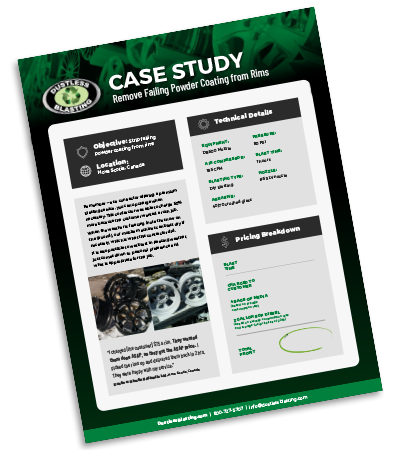Powder Coating:
The Superior Surface Finish
Free Download
The Dustless Blasting Equipment Catalog
Equipment, pricing, and the mobile blasting business opportunity.
GET THE CATALOG

What is powder coating?
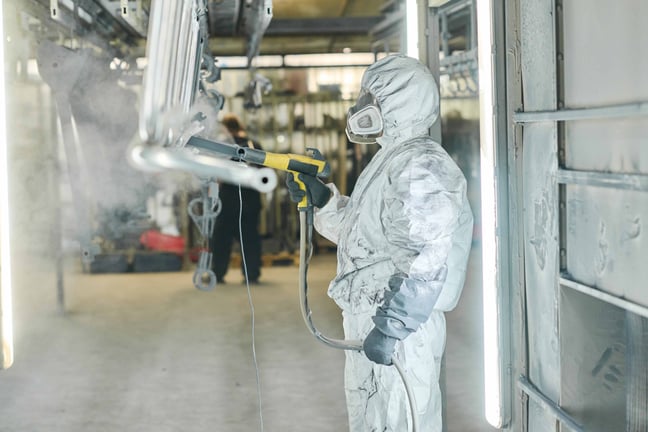 Powder coating is a dry finishing process widely used to apply a decorative or protective coating to a wide range of materials, including metal, wood, and plastic. Unlike conventional liquid paint, powder coating is applied in the form of fine dry powder, which is electrostatically charged and adhered to the surface being coated. Powder coating is known for it's long-lasting and durable exterior that keeps both the thick coatings and substrate protected for longer than traditional finishes and paints.
Powder coating is a dry finishing process widely used to apply a decorative or protective coating to a wide range of materials, including metal, wood, and plastic. Unlike conventional liquid paint, powder coating is applied in the form of fine dry powder, which is electrostatically charged and adhered to the surface being coated. Powder coating is known for it's long-lasting and durable exterior that keeps both the thick coatings and substrate protected for longer than traditional finishes and paints.
For a more in-depth look at what powder coating is, read our article.
Advantages of Powder Coating
-
Durability: Powder coating finishes offer excellent resistance to chipping, scratching, fading, and corrosion, making them highly durable.
-
Environmentally Friendly: Powder coating is a more environmentally friendly option compared to liquid paint as it produces no volatile organic compounds (VOCs) and minimizes waste.
-
Wide Range of Colors and Finishes: Powder coatings come in a vast array of colors, textures, and finishes, allowing for endless design possibilities.
-
Cost-Effective: Powder coating offers cost savings over time due to its durability, reduced rework, and less material wastage.
The Powder Coating Process
The application process consists of three main steps: pre-treatment, powder application, and curing.
Pre-treatment
Pre-treatment involves cleaning and preparing the surface to ensure optimal adhesion and corrosion resistance. It typically includes steps such as degreasing, etching, and applying a conversion coating.
Powder Application
In this stage, the powder material is applied to the pre-treated surface using a variety of techniques such as electrostatic spray, fluidized bed, or dip coating. The powder particles adhere to the surface due to the electrostatic charge.
Curing
Curing is the final step where the coated object is heated in a curing oven. The heat causes the powder particles to melt and flow together, forming a smooth, continuous film. The curing process also enhances the coating's properties, such as hardness, adhesion, and chemical resistance.
Powder Coating Application Techniques
There are a few powder coating applications that are commonly used throughout the industry. Choosing the correct coating method will come down to the type of powder coating being used, and the size or material of the item being powder coated.
ELECTROSTATIC SPRAY
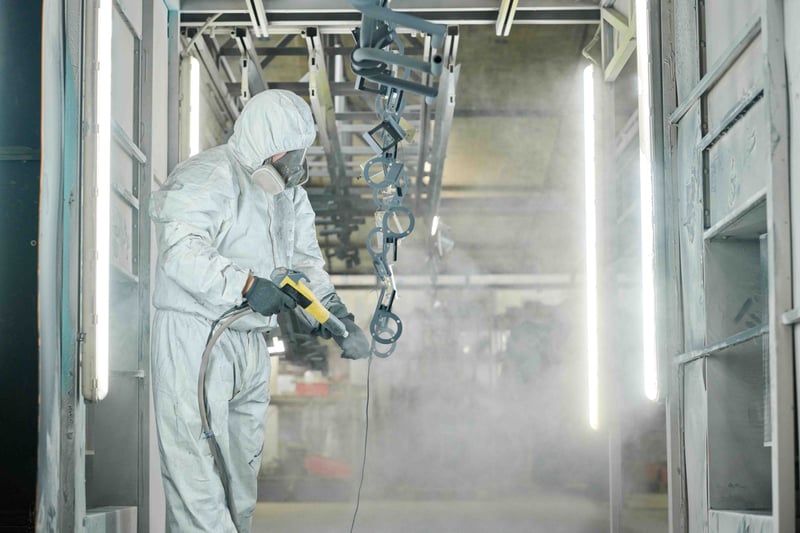
Electrostatic spray is the most widely used powder coating method, where the powder is electrostatically charged and sprayed onto the grounded object. The charged particles adhere to the surface, creating an even and uniform finish.
FLUIDIZED BED Application
The other method for powder coating works by using a fluid bed system. During this production process, the object is preheated, and then immersed in a bed of fluidized powder particles. The heat melts the powder, which forms a coating on the object's surface. The material inside of the fluidized bed system will have added compressed air into the tank, which causes the powder to flow in a more fluid state. These particles will melt as they contact the powder coating and will continue to flow together to form the full coating.
Dip Coating
Dip coating involves immersing the object into a tank filled with fluidized powder. Upon removal, the excess powder is drained off, and the coating is cured in an oven.
Electrophoretic Deposition
Electrophoretic deposition is commonly used for coating complex-shaped objects. It involves applying an electric field to attract and deposit the charged powder particles onto the object's surface.
THE CURING PROCESS
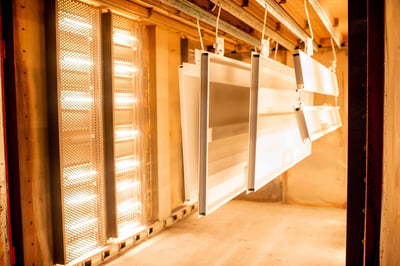
If the electrostatic spray method was used, the part will be placed in a curing oven where it will be heated at a temperature between 325-450 degrees Fahrenheit. The total time spent in the oven will vary based on thickness of the coating, and the size and surface material of the part being coated. This can range from anywhere between 10 minutes to over an hour.
If the fluidized bed method was used, the part will be heated once again in a similar fashion to curing. This heat is only used to help the coating continue to flow across the item. The heat used should only be at or around the melting point of the powder coating used.
Choosing which of the methods above to use for your item can come down to the specific powder coating that will be used or the material of the surface being coated.
Take a closer look at the powder coating application process here.
Types of Powder Coatings
There are two main styles of powder coating finishes, thermoset and thermoplastic. The difference between these two coatings are based on how they react chemically when exposed to high temperatures.
THERMOSET POWDER Coatings
Thermosetting powders, which constitute the majority of powder coatings, undergo a chemical reaction during curing that results in cross-linking. This reaction leads to a tough, durable, and heat-resistant coating. Generally, thermoset powder is only applied using the electrostatic spray deposition method. The curing process enables thermosets to attain harder coatings than thermoplastics, thus allowing them to withstand higher temperatures and demonstrate greater scratch and mar resistance. However, the hard coating can also limit the impact resistance of thermoset coatings, and over-hardening can cause the coating to become brittle, particularly in thicker coatings. Epoxy, polyester, and polyurethane are common thermosetting powder coating materials.
THERMOPLASTIC POWDER Material
Thermoplastic coatings do not undergo a chemical reaction during curing but rather melt and solidify upon heating. They offer excellent adhesion, impact resistance, and flexibility. Thermoplastic coatings do not change their physical or chemical properties when heat is applied. Therefore, they can be remelted, reformed, and recycled for future coating applications. While the ability to be remelted offers some advantage in regards to material costs, it also makes thermoplastic powder coatings less suitable for high and intense heat applications as the coating material may soften or melt off. Nylon, polyethylene, and PVC are examples of thermoplastic powder coating finishes.
RESINS
Thermoset and thermoplastic powders contain different forms of polymers called resins. These resins are the difference in the available kinds of powder coatings and are what give each specific powder it's own strengths and weaknesses. The process used to apply these types of coatings is more often decided by the general powder type (thermoplastic vs thermosetting) rather than the resin base.
Polyester. Polyester is one of the most common forms of powder coating. With a lower curing temperature than many other resin bases, polyester is a versatile coating that can be mixed with other coatings and is easier to apply to a non-metal surface. Polyesters proved added resistance to UV light and weathering, but have a lower chemical resistance. This makes them suitable for outdoor applications such as patio furniture or lawn and garden equipment.
Epoxy. Epoxy finishes provide more chemical protection as well as added corrosion resistance, and can even be used for electrical insulation. They also exhibit a smooth, uniform appearance. Epoxies are typically used for indoor applications, as one of their main drawbacks is their weakness to UV light.
Hybrids. Polyester and epoxy are two of the most popular resins used in the powder coating industry. However they have two very different sets of strengths and weaknesses. Hybrid finishes, such as epoxy-polyester, were created to maintain the advantages of both powders while helping to balance out their drawbacks.
There are a wide range of hybrid powder coatings on the market, but it is not always the right choice for your equipment. There are still times where the added corrosion durability of epoxies can outweigh the more well-rounded components of a hybrid, so be sure to consider the environment that your part will be in and know whether or not increasing the quality of UV resistance for an indoor item would be a necessity.
For more on the specific materials used in powder coats, check out our blog.
HOW To Remove Powder Coat?
Unlike paint, powder coating is known for its durability and resistance to chipping, but there may be instances when you need to remove or strip off an existing powder coat. Whether you want to refinish a powder coated part, repair a coating defect, or prepare a surface for a new coating, understanding the proper techniques for removing powder coating is essential. Below are a few ways to remove powder coating.
Abrasive Blasting
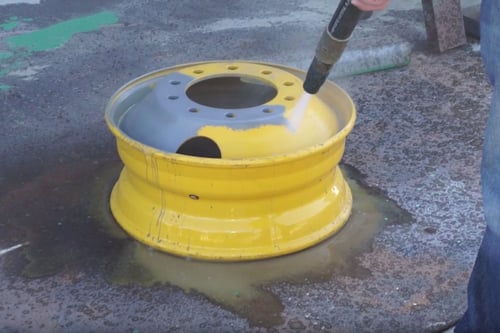
Abrasive Blasting is an industry favorite for removing tough coatings and can include both dry blasting and vapor blasting.
Most powder coating professionals prefer Dustless Blasting systems that use media propelled at high speed towards the surface to strip off the powder coating. This is because Dustless Blasting equipment can wet blast by combining water and the abrasive materials to remove the powder coat faster than dry blasting. Water cools the powder coat, making it brittle and allowing the coating to flake off into pieces instead of heating it up to melt off - causing a gooey mess.
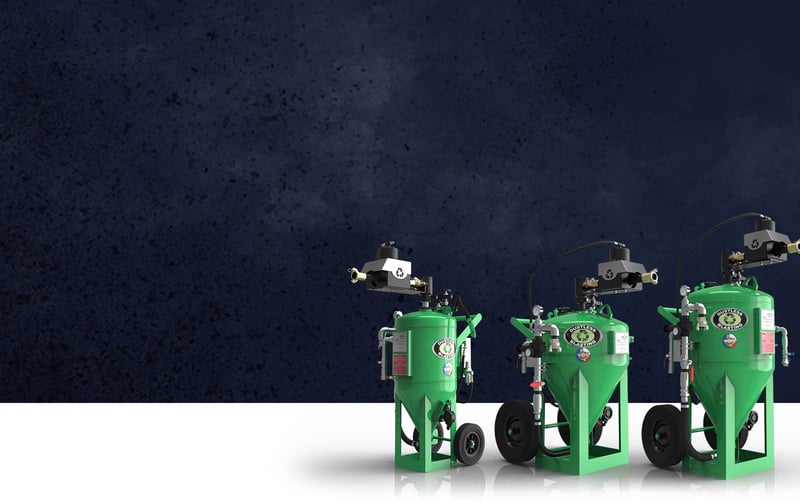
Unlike chemical stripping, media blasting leaves an anchor profile for the new paint or powder coat to adhere to the surface after blasting.
Learn more about how to remove powder coating with a Dustless Blasting machine here.
Chemical Stripping
Chemical stripping is an inexpensive and readily available method for removal. It works by applying a solvent to the powder coating that will cause the coating to dissolve, soften, or swell. Once this occurs the coating will begin to fall off, but in some cases may need to be washed off.
Chemical stripping can be dangerous. The chemicals used in the process are often toxic and can be labelled as 'hazardous waste' which means you will have to follow safety guidelines for disposing of the chemical, the stripper, and the water used when rinsing the part off.
Heat Removal
Heat removal does not have the same environmental concerns that chemical stripping does and can work even faster. It works simply by burning or baking off the coating in a high-powered, industrial strength oven. The oven used to remove the coating in this case may need to reach a temperature as high as 1200 degrees Fahrenheit. When exposed to such high temperatures though, your item is at a major risk of being warped or damaged. Deformation of metal and steel can begin as early as 600 degrees Fahrenheit.
Powder Coating FAQs
IS POWDER COATING STRONGER THAN LIQUID PAINT?
Powder coating finishes are stronger than virtually all other surface finishes. The powder coating process and application makes the coating adhere tighter to the substrate than other finishes. Conventional liquid based paint will use an evaporating solvent to get the paint to stick to the surface, which does not provide as strong of an adhesion as powder coating. The resins and powder bases give each powder coat different advantages and drawbacks. Powder coatings are often mentioned as completely resistant to rust, corrosion, impact damage, and other forms of deterioration. This is false, no powder coating is entirely resistant to harm. However even the powder coats that do not specialize in a specific area such as rust resistance, will still be less likely to rust than liquid paint and other finishing methods.
WHAT SURFACES CAN I APPLY POWDER COATING TO?
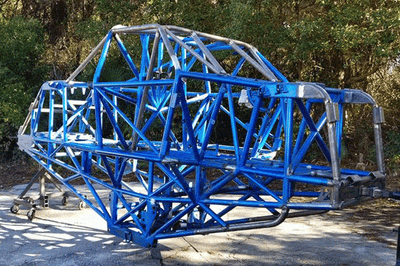
Metal surfaces are by far the most common substrate for powder coatings. Both of the methods covered here revolve around an electric charge, which surfaces like metal, stainless steel, aluminum, and other steel alloys will hold with relative ease. The powder coating process using either method will require the item be exposed to incredibly high heats, meaning that a material like rubber is not an ideal substrate. By adapting the process though it is still possible for materials like glass, wood, or plastic to be powder coated.
HOW DO I KNOW WHICH POWDER COAT IS RIGHT FOR MY JOB?
There are a lot of variables to take into account when choosing the right powder coating. You will want to take into account where the substrate will spend most of its time. A metal surface that is exposed to high amounts of UV and sunlight will likely need a different coating than a stainless steel appliance for your home. Other variables to consider are the level of gloss or shine you would like the finish to have, the thickness needed to coat the item, the likeliness of the coating coming into contact with a substance that may cause rust, corrosion, or physical damage, etc. There are plenty of aspects to consider so make sure to research each powder thoroughly.
HOW LONG DO POWDER COATINGS LAST?
The life span of a powder coated surface can vary depending on factors such as the substrate material, the kind of powder coating being used, where the powder coated item resides, and many more. The typical life span of a powder coating is around 15-20 years but can last even longer in some instances.
IS POWDER COATING SAFE?
The powder coating process is inherently environmentally friendly. There are no solvents or dangerous chemicals used in the application process or in the powder coats themselves. Powder coats also elicit minimal volatile organic compounds (more commonly called VOCs) unlike conventional paint methods. Powder coating is already compliant with environmental protection standards, as long as the components and equipment used while powder coating are up to date. Liquid paints often contain solvents and toxins that can be potentially harmful to both nearby people and the environment.
Powder coating is also easily recyclable. With the correct retreivement systems in place, any excess powder that did not adhere to the substrate when sprayed can be picked back up and used again for the next project.
IS POWDER COATING AFFORDABLE?
Powder coating is a very cost effective process on top of being a more durable finish. The stronger finish means that as time goes on there is less maintenance required to keep the coating looking good. Material costs for powder coating are typically cheaper than that of painting because the materials used are recyclable.
Download this Powder Coating Removal Case Study
Simply fill out the form to see how a Dustless Blasting business owner was able to remove powder coating from rims.
